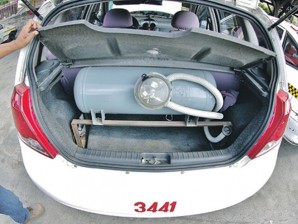A Department of Health (DOH) study has confirmed the findings of an Inquirer special report last year that warned against the health risks posed by improperly converted taxis that use auto-liquefied petroleum gas (ALPG).
Eduardo Janairo, DOH National Capital Region director, said the study conducted with the University of the Philippines-National Poison Management and Control Center (UP-NPMCC) showed that the improper conversion of taxis could expose cabdrivers and passengers to ALPG.
Janairo said the Center of Health-NCR conducted the rapid health assessment study because of the rising number of complaints of “dizziness, headache, light-headedness and dryness of throat among taxi drivers whose vehicles were LPG-converted.”
Janairo said overexposure to ALPG could lead to “unconsciousness and even death.”
“It is important that installations should be done only by an ALPG installer approved by the Department of Trade and Industry to ensure that the setup is correctly done,” Janairo said in a statement.
“A list of legitimate, accredited and certified service providers should be disseminated to the transport sector in order to avoid [proliferation of] fly-by-night operators,” he said.
“Only by introducing regulations and standards to ensure the safe use of ALPG can we ensure the health and safety not only of drivers but also passengers,” Janairo added.
Complaints
“We would like to set policy directions on the implementation of standards and guidelines in auto LPG-[powered] vehicles and determine the potential exposure and health effects among population groups exposed to these vehicles compared to population groups exposed to [conventional vehicles],” Janairo said.
He said the study showed that the effects of exposure to auto-LPG include headaches, back pain or nape pain, chest pain, cough, dizziness, dry throat, fatigue and muscle weakness, nausea and breathing difficulty.
The study found that these are due to decreased delivery of oxygen to the body’s vital organs. It also found that “overexposure may cause unconsciousness and even death.”
Janairo said the study also found that the amount of hydrogen sulfide (H2S) was 68 times higher and carbon monoxide (CO) levels were eight times greater for auto-LPG retrofitted vehicles than those measured in conventional vehicles.
Dangerous emissions
The emission of dangerous chemicals within the vehicles may be due to improper conversion, lack of regular environmental monitoring of the vehicles and poor maintenance of the vehicles, he added.
Janairo said the study covered 26 ALPG and 13 conventional-vehicle male drivers who were randomly selected from a list of users of auto LPG-powered vehicles and users of conventional vehicles (diesel and gasoline).
The drivers were aged 18 to 45 years old, with two years of experience driving only one type of vehicle or working in the station, and were not smokers, Janairo said.
The study covered 53 taxis: 28 ALPG taxis, and 25 gasoline or diesel taxis, he added.
Alternative fuels
The passage of the Clean Air Act of 1999 and the Biofuels Act of 2006 introduced biofuels in the country and use of other alternative fuel sources to reduce dependence on petroleum-based fuels.
One of the most widely used alternative fuels is the autogas, also known as automotive LP gas, or auto-LPG.
ALPG is cleaner than conventional automotive fuels. It is a mixture of light hydrocarbon gases propane (30 percent) and butane (70 percent), Janairo said.
Because of its environmental and economic benefits, auto-LPG was considered one of the best alternative automotive fuels in the country and was introduced in 2005, he added.
Janairo said 19,052 taxis were converted from 2005 to 2011, or an average of 2,000 taxis a year, with 217 refilling stations being built nationwide. Thirty-one auto-LPG conversion shops have been licensed to service vehicles.
Human factor
Janairo said countries with large numbers of LPG vehicles and high consumption of ALPG include the United States, Japan, Australia and Canada.
But studies from these countries have found that there is no evidence to show that LPG is more dangerous or less dangerous than gasoline or diesel, Janairo said.
The studies showed that human factor plays a major role in affecting safety in the use of LPG fuel. In Japan, there is no recorded explosion or a serious accident for 30 years since the introduction of various safety measures regulating the use of LPG fuel, Janairo said.
Canada also reported human error—careless fuel handling and faulty workmanship—as the major cause of accidents involving LPG vehicles. There were 25 accidents reported during refueling, indicating the danger during that stage of operation, he added.
Recommendations
Janairo said the DOH study strongly recommended a review and revision of occupational health programs for drivers to prevent the occurrence “or progression of disease/sickness brought about by exposure to ALPG.”
There should also be strict air-quality testing to determine adequate oxygen (O2) level, ventilation and chemical contaminants in the vehicle, “which can be done during the resealing process at the [Land Transportation, Franchising and Regulatory Board],” he said.
Ventilation of the vehicle should also be considered “during idle times to allow fresh air to enter the vehicle and establish regulatory standards on the permissible level of odorants that can be added to auto-LPG fuel,” Janairo said, quoting from the study.
Other recommendations included strict observation of the maintenance schedule for both ALPG and conventional vehicles prior to registration; introduction of realistic work schedules for drivers; and evaluation of ergonomic and other chemical hazards for transport workers, Janairo said.
